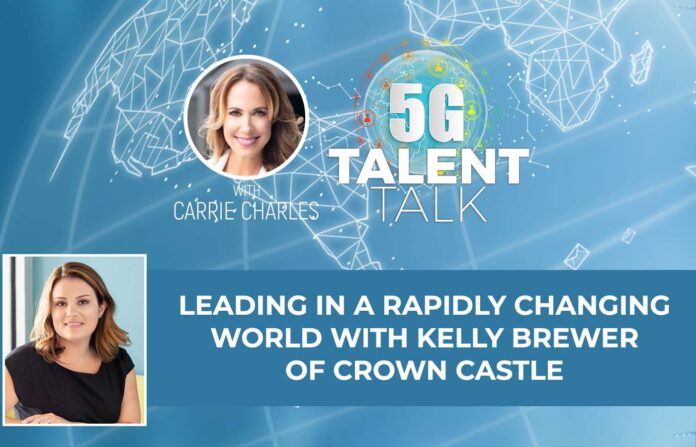If you don’t work in the telecom industry, you might not recognize that you’re indirectly interacting with Crown Castle every day. But as one of the largest providers of shared communications infrastructure in the US, Crown Castle’s impact on the shared infrastructure space is undeniable. With 40,000 cell phone towers, 85,000 route miles of fiber and over 115,000 small cells in some sort of deployment, Crown Castle’s network is always expanding.
In this episode of 5G Talent Talk with Carrie Charles, Kelly Brewer shares her career journey leading to Crown Castle, her perspective on the changes in the industry over recent years, and where she thinks communications infrastructure will be going in the future. Carrying a unique perspective of having one foot each in construction and tech, Kelly shares her interesting insights on leadership in a rapidly evolving industry.
—
Watch the episode here
Listen to the podcast here
Leading in a Rapidly Changing World with Kelly Brewer of Crown Castle
I am so glad you’re here. I have a special guest with me, a woman I’ve known for many years, Kelly Brewer. She is the Vice President of Operational Strategy and Innovation with Crown Castle. Kelly, thank you so much for coming to the show.
Thanks for having me. I appreciate it.
I am excited to get started because I know that you have an incredible journey that has gotten you to where you are. Can you share that?
My journey has always been in construction or infrastructure. I started my early career in construction. I always knew that I had a desire to lead and build something that mattered, specifically something physical in the world. I spent my early career in highway construction and did a short stint in building construction. I went to school for business and minored in construction. I always knew that I’d do something relative to that industry.
In my heart of hearts though, I’ve always been an entrepreneur too. If there was a way that I was going to drive my career, it is going to be in this space, but with an entrepreneurial journey, if you will. In one of the early companies I was with, I met my husband. We had worked together for a couple of years and then I decided it was probably time to not work in the same space, move on, and look for something that scratched that entrepreneurial edge.
Living in Portland, Maine, I was interested in looking for a startup. Portland, Maine is not typically known for a startup mentality or an environment back more than a decade or so ago. I found Tilson, which at the time was a startup. There were eighteen people in its early days. Tilson was focused on ERP system implementations for large construction companies, but it had also won a BTOP NTIA grant to build 1,100 miles of fiber in the State of Maine. I thought, “This is an interesting company.”
It is a company that is in the construction space and looking to build impactful infrastructure. It also has a technological edge to it, which was interesting and different for me. I also took the attitude that building roads and fiber got to be very similar. It’s both linear and in the right of way so there’s got to be some alignment there. Tilson also had the desire to build the company. That was something that I was super interested in as well.
I jumped right in and spent my career building two things, focusing on building infrastructure that mattered in the world and community. I was also interested in building a culture and a company that mattered, something that the team was proud of and that could continue to build opportunities for our team. I knew that to create opportunity, we had to create growth and creating growth meant that we were doing more things in the world and building more infrastructure. Those two missions and things that lit me up luckily went hand-in-hand. That was exciting.
Over the past, about a little more than a decade or so, we’ve seen the convergence of wireless and wireline. That started to increase, particularly as infrastructure moved into the right of way with small cells and other deployments. I’ve been particularly interested in this topic, both in aligning how the work gets done by building a workforce that can deliver wireless and wireline infrastructure since we’re building in a lot of the same places and also in the evolution of the industry as we start to deliver infrastructure that’s going to serve multiple purposes and end users.
I’ve always been a real believer in shared infrastructure as we start to see how hard it is to build as much infrastructure as we need in the places that we live and the communities we work in. Ultimately, that belief in shared infrastructure is what led me to Crown Castle. I’ve been here for several months and it’s been great so far.
Probably everyone on earth knows who Crown Castle is but in case some readers do not know, could you please give a brief introduction of Crown Castle?
It’s funny. I’m not sure that everybody on earth knows Crown Castle unless you’re in the space or an avid investor and REITs are part of your investing strategy. I have people that I have talked to that knew about my past company Tilson because they’ve been in and around my life but had not heard of Crown Castle, which is also a Fortune 500 company. It’s an interesting transition that if you’re in the space, you know who Crown Castle is.
Outside of that, Crown Castle is a large company that people interact with indirectly or directly every day and don’t necessarily know about it. Crown Castle is the largest provider of shared communications infrastructure in the US. We have 40,000 cell phone towers, 85,000 route miles of fiber and over 115,000 small cells in some form of the deployment phase. A lot of infrastructures are being built for that shared purpose. We leverage that infrastructure for multiple customers. Our goal is to provide speed, quality and predictability for our customers who want to lease and leverage our shared platform.
Kelly, you were with Tilson for ten years.
Almost eleven.
After a long time with Tilson and Crown, has your perspective changed on the industry, maybe the state of the industry where we are in 2022 or where we’re going?
The entire environment has changed. Ten years is a long time. In this industry, change is inevitable but the macro environment has been particularly challenging and changing. There have been so many large macro shifts like COVID, Sprint and T-Mobile acquisition, spectrum options, the release of billions of dollars in Federal funding, all of these things that are coming in and shaping our customer strategies, the marketplace, the environment, how people live and work and what their priorities are. Balancing all those things with also the evolution of technology is driving change at a continued exponential rate.
One thing that hasn’t changed is the continuous change in evolution. Over time too, this convergence of wireless and wireline has also created the addition of new people leveraging communications infrastructure, which I’ve seen in ten years. New companies are cropping up. There are different end-use applications. Technology is improving. People are stitching together solutions that combine different technologies and infrastructure platforms to be able to serve end users, which is interesting and great.
It is also a proof point that shared infrastructure is a way to help deliver on that. Some companies are great at delivering end-user products and they’re going to need infrastructure to support them. The core carrier business is alive and well. There’s a new entrance into the market, which is also interesting in creating a new environment. If nothing else, it has reaffirmed my belief in shared infrastructure and the need for that speed, cost and predictability of deployment.
Kelly, I have known you ever since I’ve been in the industry. I have always had such great respect for you as a leader. I’d love to hear a little bit about what guides you in leadership, maybe some of your leadership principles.
I was talking to my team about some of the things that have shaped my leadership style and strategy over the years. I would say probably the biggest thing that has made a mark that has fundamentally changed how I lead or think about leadership is some of the points from the advantage, specifically on focusing on keeping your organization smart and things like strategy, operations, legal and all the things that everyone focuses from a smart standpoint.
How do we also focus on keeping a healthy culture, free of politics, creating clarity and making sure that the leadership team is cohesive, we’re overcommunicating on that vision and then reinforcing that clarity with all of the things that we do. Fundamentally, for me, how we move as fast as this industry is moving and delivering is we’re going to have to have an organization and a culture that is strong, healthy and super aligned. The simpler you can create, the better it is for both the employee experience and your ability to navigate complexity very quickly.

What about developing leaders? Do you have a particular strategy that works for you or has worked for you in the past?
It depends on the individual and the path that they want to choose. Being engaged both as a mentor and a leader is important in developing new leaders. 1) Being able to identify new talent. 2) Giving them experience and exposure to new opportunities is going to be the best way for them to learn. I’m a big fan of having a foundation in reading and learning in academics.
Also, a lot of my most formative learning has come from being on the job, experiencing things, having to solve problems and collaborating with people that have different experiences and skills that I have that start to give me different contexts. Context is important. We’re not always great at providing the context but giving people exposure to new ideas and people that have different experiences gives them context to be able to make new decisions. That helps a lot with growth.
Let’s talk a little bit about attracting talent and strategies that are working for you at this time or maybe for Crown in general to attract talent. It’s tough out there. We know that. It doesn’t seem to be getting any better. We’ve got the Great Resignation and something called quiet quitting. There’s a new term that comes up every week for what’s happening in our workforce. Is there anything that’s working for you?
We’re in a weird moment. The labor market is still tight so that’s an interesting dynamic. Also, you’re hearing headlines about tech companies making other shifts in their labor. That is a conflicting report. I still think the labor market is going to continue to be tight for the top talent. Leveraging technology like LinkedIn or your network and referrals is going to be some of the best ways to bring in people that you know or have other experiences.
I love the focus on diversity, equity and inclusion from the standpoint of getting more candidates in the pipeline. Employers are focusing more too on casting a wider net and being more deliberate about that. Casting a net that’s broader also helps drive talent into the organization, which has been interesting and helpful. Building a diverse and inclusive workforce is important as we start to take on new and interesting challenges.
Building a diverse and inclusive workforce is important as we start to take on new and interesting challenges.
The other thing is being responsive is being respectful. During the whole employment process, employers have a responsibility and timely communication. It’s the first engagement with a potential new teammate. Being engaged and responsive during that process will improve their opportunities to secure talent.
That is the most important thing I’ve heard in a long time where a leader will say, “Responsiveness is crucial. Talent flies off the shelves.” It’s crucial that that leader is responsive and gives that feedback either to their recruiting team or that candidate. Many of them are sitting with multiple offers. It’s brilliant. I’m so glad that you said that.
I’m curious about your rise to your position as a woman in telecom. It’s a male-dominated industry. There could be many women in the audience reading and saying, “I would like to be where Kelly is someday. Are there any challenges that she’s overcome?” Maybe some advice that you could give to other women who are looking to climb that ladder and get to a leadership role.
In any traditionally male-dominated industry, I knew going in that that was going to be the case and that I would probably be in the minority. Not that that’s bad. Construction generally attracts more men than women. I knew that that was going to be a challenge. Telecom was the same way but the good news is it’s getting better. There’s more awareness of what opportunities exist in telecom and construction for women. That’s been particularly helpful.

As more women have joined the workforce in general and also some of these companies, you can start to imagine and expand the circles in what you’re recruiting, which has been particularly helpful. Having women in positions of leadership and also being part of the team has made it helpful. Companies need to take steps to recognize talent, male or female, and then continue to promote those particular individuals.
For myself, my biggest advocates for my success in my entire career have been men, which has been great. I want to celebrate and support the men that support women in the workforce. Going into a male-dominated industry, you’re not always going to have a woman leader and you’re going to want to have advocacy from men. We should celebrate and support the men that support women in leadership roles and in the workforce. I’ve been fortunate that I’ve been working closely with people like that. I’ve tended to gravitate towards companies and people that support that type of diversity.
Crown Castle is one of those companies. We have had such success at Broadstaff working with Crown Castle and staffing for Crown for years. I’d love to hear more about the culture of Crown Castle. This is one of the cultures that we’ve emulated with Broadstaff because it’s incredible. I want to tell everyone about it. From your perspective, what makes Crown Castle unique?
Our B3 values first are the pillar of the culture. If nothing else, that’s universal across Crown. It’s Be real, which resonates, Be accountable, and Be an owner. That speaks to both creating shareholder value, as well as being accountable to deliver for our customers and then being real with each other. Those values are things that we live by and show up. That was something that attracted me to Crown Castle.
In addition to those values being a pillar of how we live and work, I found that Crown’s culture is collaborative. Probably some of the most collaborative I’ve seen. A lot of people want to work together with different experiences and backgrounds. People are excited about helping each other out and working cross-functionally. That’s been such a joy to get to know the team in that way and solve problems together. Work is more fun when you can leverage the experiences of other teammates. Crown’s culture has been great.
I’ve also appreciated the smartness, disciplined and committed to the vision that Crown has. The discipline helps make strong investment choices and decisions. We hire smart, capable and talented people. Having the discipline but also being thoughtful about the future allows us to be innovative and creative, as well as make the best decisions for our shareholders.
Coming here, it’s been great. I’ve been excited to bring my strength in being an entrepreneur and my experience building the assets that Crown owns. Having that different perspective and being married to the other teammates has been a good fit. I hope to continue to find new ways to deliver value through Crown’s unique portfolio of assets and work with the team every day. That’s been fun.
Ever since I’ve known you, you’ve achieved this thing called balance that we all work to achieve, men and women. We try to achieve this balance in our lives of family, leadership and career. It’s tough. I feel that you have some wisdom to share there.
I always think of that work-life balance. Years ago, I’ve called it more work-life integration because I have a hard time having a very delineated work versus life experience. I’ve always felt like that’s a personal path. You have to figure out what works for you. Different people have different circumstances where they live, what their home life is like, whom they have for support and all that.
Some of the keys to my success is I have an amazing spouse that helps me out a lot. He’s not intimidated by gender stereotypes on roles, which has been particularly helpful for me in achieving success. I’ve been able to put in the time on my career while also balancing having a family and all that. I have three kids. They range in age. Having help has been particularly important with a spouse.
Also managing your boundaries. Sometimes, admittedly, I’m not great at managing those boundaries and that’s why I blur it with more of an integration piece. I’ll never miss something important to my kids at school. I’m always there. At the same time, there’s a sacrifice to be able to do some of the things that I want to do for my career. I don’t view it as a sacrifice. I view it as balancing. Sometimes I’m going to get on an airplane and be gone overnight.
It’s figuring out what those boundaries are that work for you, and then working around the other parts of your life so that you don’t feel burnt out or you’re having to give up too much of yourself. Find a system that works and then keep it simple. If you can get it out of your head, then you can create emotional space to be able to balance both things.
Figure out the boundaries that work for you and then work around the other parts of your life so you don’t get burnt out. Find a system that works and keep it simple.
Keep it simple. We need to know that after what we’ve been through with the pandemic. It’s a message that we need. Kelly, thank you so much for being on the show. If you could give us some information about where we could go to find out more about Crown Castle jobs.
You could visit the Crown Castle website at CrownCastle.com. All of our roles are posted on LinkedIn. You can look them up there. Also, feel free to reach out to me on LinkedIn if I can help with career fit at Crown.
Kelly, thank you so much. This has been a pleasure. It’s great to catch up with you again. I hope to see you soon somewhere on your travels.
Thanks, Carrie.
Important Links
- Crown Castle
- Broadstaff
- LinkedIn – Crown Castle
- Kelly Brewer on LinkedIn
About Kelly Brewer
 Kelly Brewer serves as Vice President, Operational Strategy & Innovation at Crown Castle, a Fortune 500 company, and leader in shared telecommunications infrastructure. Kelly is responsible for improving strategic capital allocation and strategic operational decisions through innovations in network technology, deployment methods, and business models.
Kelly Brewer serves as Vice President, Operational Strategy & Innovation at Crown Castle, a Fortune 500 company, and leader in shared telecommunications infrastructure. Kelly is responsible for improving strategic capital allocation and strategic operational decisions through innovations in network technology, deployment methods, and business models.
Prior to Crown, Kelly served as Chief Operating Officer for Tilson, a nationwide telecommunications infrastructure design build firm focused on wireless, fiber, and infrastructure projects for carrier and non-carrier customers. Kelly joined Tilson in 2011 and led the company through significant and sustained growth that landed Tilson on the Inc. 5000’s list of Fastest Growing Companies in America for the past 11 consecutive years.
Kelly holds a BS in Business from the University of Southern Maine and an MBA from Mississippi State University. Kelly serves on the USM Foundation board and is a board member for Landry/French Construction, a general contractor.
Love the show? Subscribe, rate, review, and share!
Join the 5G Talent Talk Community today:

